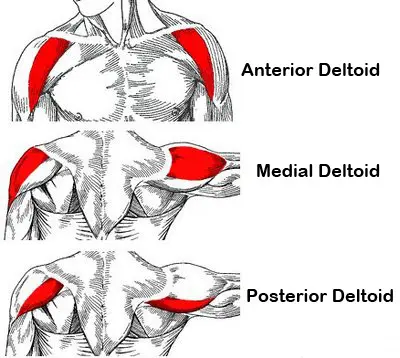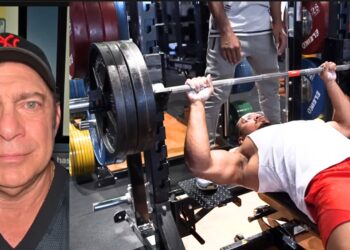Big, muscular shoulders significantly enhance your physique. In regular clothes, they give your upper body an impressive, powerful outline. With your shoulders exposed, they link your chest with your arms to create a pleasing line and shape.
Building strong shoulders requires dedicated time and focused training. Beyond aesthetics, strong shoulders are crucial for functional strength and athletic performance.
As a veteran personal trainer with over 35 years in the industry, I’ve helped many clients develop bigger and stronger shoulders. In this article, I reveal my 15 favorite bodybuilding exercises for developing bigger anterior delts.
Recent Updates: On June 20, 2024, Fitness Volt’s Senior Editor Vidur Saini (American Council on Exercise-CPT) updated the article and added actionable expert tips throughout to improve the reader experience.
15 Best Front Delt Exercises for Bodybuilders
Not sure how to start building bigger front deltoids? Begin by including some of these exercises in your upper body workouts:
- Barbell Overhead Press
- Dumbbell Overhead Press
- Arnold Press
- Z-Press
- Push Press
- Cable Shoulder Press
- Cable Front Raise
- Dumbbell Front Raise
- Bus Drivers
- Pike Push-Up
- Handstand Push-Up
- Battle Rope Alternating Slam
- Kettlebell Swing
- Bradford Press
- Bench Press
1. Barbell Overhead Press
| Sets & Reps | Equipment Needed | Target Muscles |
| 3 x 8-12 (Hypertrophy); 5 x 5-6 (Strength) | Barbell | Anterior and medial deltoids, triceps brachii |
The barbell overhead press is a bodybuilding staple. Pressing a barbell overhead is a great way to build muscle size and strength in your deltoids and triceps. It’s also a classic test of strength.
Level Up Your Fitness: Join our 💪 strong community in Fitness Volt Newsletter. Get daily inspiration, expert-backed workouts, nutrition tips, the latest in strength sports, and the support you need to reach your goals. Subscribe for free!
“The barbell overhead press is a true test of upper body strength and stability and is a cornerstone movement for building powerful shoulders and triceps,” says Saini.
Pro Tip: Control the eccentric phase (lowering the bar) by taking 3-4 seconds to descend, maximizing time under tension and stimulating muscle growth.
| Difficulty | Progression | Regression |
| Intermediate | Strict press, behind-the-neck press | Dumbbell overhead press, seated overhead press |
Read more about barbell overhead presses here.
2. Dumbbell Overhead Press
| Sets & Reps | Equipment Needed | Target Muscles |
| 3 x 8-12 (Hypertrophy); 4 x 6-8 (Strength) | Dumbbells | Anterior and medial deltoids, triceps brachii |
While the barbell overhead press is a classic anterior deltoid exercise, some lifters find that having their hands fixed in one position causes shoulder pain. Using dumbbells means you can modify the range of motion to suit your anatomical needs for a more comfortable workout.
Dumbbell overhead presses allow for a greater range of motion and can help correct muscle and strength imbalances, suggests Saini.
Pro Tip: Initiate the movement by driving your elbows out and up, not straight up, to engage the deltoids fully and maintain shoulder health.
| Difficulty | Progression | Regression |
| Beginner | Unilateral overhead press, Arnold press | Seated dumbbell overhead press, half-kneeling press |
Read more about dumbbell overhead presses here.
3. Arnold Press
| Sets & Reps | Equipment Needed | Target Muscles |
| 3 x 8-12 (Hypertrophy); 4 x 6-8 (Strength) | Dumbbells | Anterior, medial, and posterior deltoids, triceps brachii |
Named after bodybuilding legend Arnold Schwarzenegger, this exercise hammers your anterior deltoids. Compared to regular dumbbell overhead presses, you probably won’t be able to use such heavy weights when doing the Arnold press. However, it provides an excellent workout for your delts.
Some bodybuilders find the Arnold press a little shoulder unfriendly, so progress with care. Arnold presses can be done seated or standing and using dumbbells or kettlebells.
Saini adds that the unique rotation in the Arnold press engages all three heads of the deltoid, leading to more well-rounded shoulder development.
Pro Tip: At the top of the movement, focus on squeezing your shoulder blades together to activate the lower traps and prevent excessive internal rotation.
| Difficulty | Progression | Regression |
| Intermediate | Standing dumbbell press | Seated dumbbell press, dumbbell lateral raise |
Learn how to overhead press like Arnold here.
4. Z-Press
| Sets & Reps | Equipment Needed | Target Muscles |
| 3 x 8-12 (Hypertrophy); 5 x 3-5 (Strength) | Barbell | Anterior deltoids, triceps brachii |
The Z-press is a challenging overhead pressing variation invented by strongman legend Žydrūnas Savickas, better known as Big Z. This exercise is done while sitting on the floor with your legs extended out in front of you, requiring core strength for stabilization and eliminating leg drive.
“The Z-Press forces you to maintain strict form, eliminating momentum, and places extra emphasis on core stability for a stronger overhead press,” adds Saini. However, you need decent overhead and thoracic mobility to perform this exercise correctly.
How to do it:
- Sit on the floor between the uprights of a squat rack with your legs straight and spread wide for balance.
- Place a barbell on the J-hooks at about shoulder height.
- Sit up tall, brace your abs, and hold the bar with an overhand, slightly wider than shoulder-width grip.
- With your core tight and shoulders down and back, unrack the bar and hold it across your shoulders as you would for regular overhead presses. Do not lean forward or back. Lift your chest.
- Keeping your core tight, press the bar up and overhead.
- Lower the bar back to your shoulders and repeat.
- Focus on maintaining a good upright posture and tight core throughout. Do not allow your lower back to round.
Pro Tip: Brace your core and maintain a slight arch in your lower back throughout the lift to prevent spinal rounding and ensure optimal force transfer.
| Difficulty | Progression | Regression |
| Advanced | Z-press using an earthquake bar | Seated overhead press, dumbbell overhead press |
Learn how to do the Z-press here.
5. Push-Press
| Sets & Reps | Equipment Needed | Target Muscles |
| 3 x 8-12 (Hypertrophy); 5 x 3-5 (Strength) | Barbell | Anterior and medial deltoids, triceps brachii, quadriceps, glutes |
The push press is another classic barbell exercise, although it can also be done using dumbbells or kettlebells. With the push press, you use your legs to help drive the weight up and overhead.
While some may view this as cheating, it’s a legitimate method for lifting heavier weights or extending your set past failure. Ensure you lower the bar under control to maximize deltoid engagement.
Saini suggests that the push press teaches you to use your legs to generate power, translating to bigger lifts in other compound exercises like the snatch and clean.
How to do it:
- Stand with your feet between shoulder and hip-width apart.
- Using an overhand grip, rack and hold your barbell across the front of your shoulders. Your hands should be just outside shoulder-width apart. Raise your elbows slightly so they are in front of the bar.
- Brace your core, pull your shoulders down and back, and lift your chest.
- Without leaning forward, bend your knees and descend into a quarter-depth squat. Imagine you are setting up for a vertical jump. Keep your heels on the floor.
- Rapidly extend your knees and hips and use this momentum to help you drive the bar up and overhead.
- Receive the bar overhead with your knees, hips, and arms extended.
- Lower the bar back to your shoulders and repeat.
Pro Tip: Drive through your heels and extend your hips explosively as you press the bar overhead, maximizing the contribution of your lower body.
| Difficulty | Progression | Regression |
| Intermediate | Split jerk, power jerk | Barbell overhead press, seated overhead press |
6. Cable Shoulder Press
| Sets & Reps | Equipment Needed | Target Muscles |
| 3 x 10-15 (Hypertrophy); 4 x 6-8 (Strength) | Cable Machine | Anterior and medial deltoids, triceps brachii |
While there is nothing wrong with training your anterior deltoids with free weights, cables are also beneficial.
With cable exercises, your muscles are under constant tension, creating more metabolic stress and a better pump. Cable machines are also perfect for intensity-boosting drop sets.
Cable shoulder presses can be done using both arms or one arm at a time.
Saini suggests experimenting with different wrist positions according to your biomechanics. Some lifters hold the handles with a neutral grip in the bottom position and rotate their wrists externally on the concentric phase.
Pro Tip: Lean slightly forward and keep your elbows high throughout the movement to create a more pronounced arc and increase your range of motion.
| Difficulty | Progression | Regression |
| Beginner | Single-arm variation | Seated dumbbell shoulder press, wall slides |
Read more about this effective anterior deltoid exercise here.
7. Cable Front Raise
| Sets & Reps | Equipment Needed | Target Muscles |
| 3 x 12-15 (Hypertrophy); 3 x 8-10 (Strength) | Cable Machine | Anterior deltoids |
All pressing exercises are compound in nature, meaning they involve your triceps as well as your deltoids. However, single-joint isolation exercises can also help build bigger anterior deltoids.
Doing front raises with a cable is a great way to keep your front delts under constant tension and is also a very shoulder-friendly exercise. Use light to moderate weights and medium to high reps for this exercise.
You can do cable front raises with two cables or a single cable.
Saini recommends pausing briefly at the top of each rep and squeezing your front delts hard to maximize muscle activation and enhance mind-muscle connection.
Pro Tip: The cable front raise isolates the anterior deltoids and allows for controlled, smooth movements, reducing the risk of injury.
| Difficulty | Progression | Regression |
| Beginner | Unilateral front raise | Dumbbell front raise, incline dumbbell raise |
8. Dumbbell Front Raise
| Sets & Reps | Equipment Needed | Target Muscles |
| 3 x 12-15 (Hypertrophy); 3 x 8-10 (Strength) | Dumbbells | Anterior deltoids |
Dumbbell front raises are a classic old-school anterior deltoid exercise. They can be done seated or standing, raising two dumbbells at once or lifting one at a time. Raise your arms until they’re parallel to the floor and not much higher. Lifting your arms above parallel increases the risk of shoulder impingement and upper trap activation.
The dumbbell front raise is a versatile exercise that can be done seated, standing, or even kneeling to hit your front delts from various angles, adds Saini.
Click the links to learn how to do:
Level Up Your Fitness: Join our 💪 strong community in Fitness Volt Newsletter. Get daily inspiration, expert-backed workouts, nutrition tips, the latest in strength sports, and the support you need to reach your goals. Subscribe for free!
Additionally, you can do front raises with a barbell or a weight plate.
Pro Tip: Turn your thumbs slightly upward at the top of each rep to create external rotation in the shoulder joint, increasing anterior deltoid engagement.
| Difficulty | Progression | Regression |
| Beginner | Increase weight, unilateral front raise | Wall slides, band front raise |
9. Bus Drivers
| Sets & Reps | Equipment Needed | Target Muscles |
| 3 x 15-20 (Hypertrophy); 3 x 10-12 (Strength) | Plate, Weight Plate | Anterior, medial, and posterior deltoids, rotator cuff |
This exercise is a variation of weight plate front raises, which you’ll find discussed above (exercise number eight). It’s a very straightforward movement and ideal for use as a finisher for your deltoid workouts. However, it creates a deep burn and pump, so don’t go too heavy too soon!
“Bus drivers are an excellent way to improve shoulder mobility and stability, which can enhance your performance in other pressing movements,” says Saini.
How to do it:
- Hold a weight plate out in front of you with your arms straight and hands facing one another. Brace your core and pull your shoulders down and back. Do not lean backward.
- Keeping your arms extended, rotate the plate to the left and right like you are turning a steering wheel. Keep your arms parallel to the floor.
- Continue until you are unable to keep your arms up.
Pro Tip: Focus on keeping your elbows locked out and maintaining a smooth, controlled tempo to maximize time under tension and avoid momentum.
| Difficulty | Progression | Regression |
| Intermediate | Dumbbell front raises | Banded front raises |
10. Pike Push-Up
| Sets & Reps | Equipment Needed | Target Muscles |
| 3 x To Failure (Hypertrophy); 4 x 8-12 (Strength) | None | Anterior deltoids, triceps brachii |
You can develop your anterior deltoids using just your body weight. This exercise takes the humble push-up, which is usually more of a chest exercise, and makes it much more anterior deltoid-focused.
This exercise is a great stepping stone towards handstand push-ups, says Saini.
How to do it:
- Get down on the floor in the push-up position, hands slightly wider than shoulder-width apart. Brace your abs and pull your shoulders down and back.
- Keeping your legs straight, lift your butt up toward the ceiling so that your body forms an inverted V. Move your feet closer to your hands if necessary.
- Without lowering your hips, bend your arms and lower your head to the floor.
- Push yourself back up and repeat.
- Increase your range of motion, and therefore the difficulty of the exercise, by using push-up handles or placing your hands on stacked weight plates or yoga blocks.
Pro Tip: Engage your core and glutes to maintain a hollow body position throughout the movement. This will prevent lower back hyperextension and ensure proper form.
| Difficulty | Progression | Regression |
| Intermediate | Elevated feet pike push-up, handstand push-up | Incline push-up, kneeling push-up |
11. Handstand Push-Up
| Sets & Reps | Equipment Needed | Target Muscles |
| 3 x To Failure (Hypertrophy);4 x 5-8 (Strength) | Wall | Anterior deltoids, triceps brachii |
If you’ve mastered pike push-ups and want to overload your delts and triceps with more weight, try handstand push-ups. This is much more challenging as you’ll be lifting your entire body weight.
Handstand push-ups can be done with your feet against a wall for stability or if you’ve got great balance without support. However, you’ll need to master freestanding the handstand first!
Saini calls the handstand push-up the king of bodyweight shoulder exercises, as they demand incredible strength, control, and balance.
Pro Tip: Protract your shoulder blades at the bottom of each rep, pushing your hands away from your body to increase your range of motion and activate the serratus anterior.
| Difficulty | Progression | Regression |
| Advanced | Freestanding handstand push-up | Pike push-up, elevated feet push-up |
Learn how to do handstand push-ups here.
12. Battle Rope Alternating Slam
| Sets & Reps | Equipment Needed | Target Muscles |
| 3 x 30-60 seconds | Battle Ropes | Full body, primarily shoulders and core |
Battle ropes are mostly considered a conditioning tool but may also be useful for building muscle mass. Alternating slams are a lot like doing dynamic front raises and are an effective anterior deltoid exercise. An exercise that builds muscle, improves overall fitness, and burns fat simultaneously — what’s not to love?!
“Battle ropes are a full-body conditioning tool, and the alternating slam is a metabolic powerhouse that will leave you breathless,” says Saini.
Pro Tip: Focus on generating power from your hips and core, not just your arms, to maximize calorie burn and improve overall athleticism.
| Difficulty | Progression | Regression |
| Beginner | Increase intensity, double slams, power slams | Single arm slams, lower slam height, lighter ropes |
Learn how to do this exercise here.
13. Kettlebell swing
| Sets & Reps | Equipment Needed | Target Muscles |
| 3 x 12-15 (Hypertrophy); 5 x 5-8 (Strength) | Kettlebell | Posterior chain (glutes, hamstrings), core, shoulders |
Most people do kettlebell swings for fat burning and conditioning or to develop their glutes and posterior chain. However, they’re a pretty decent anterior deltoid exercise, too. After all, if you take a moment to analyze the movement, you’ll see that the arms replicate a front raise.
To make the kettlebell swing more anterior deltoid-dominant, actively use your shoulders to raise the weight and then decelerate it as you lower it again.
Pro Tip: Hike the kettlebell back between your legs like a football for a deep shoulder stretch, then explode forward using your shoulders for a peak contraction.
| Difficulty | Progression | Regression |
| Beginner | Dumbbell front raise | Banded front raise |
14. Bradford Press
| Sets & Reps | Equipment Needed | Target Muscles |
| 3 x 8-12 (Hypertrophy); 4 x 6-8 (Strength) | Barbell | Anterior deltoids, triceps brachii |
The Bradford press is an old-school shoulder exercise that keeps your deltoids under constant tension. Because it involves a behind-the-neck press, it’s not an exercise for everyone.
If you have tight or painful shoulders, proceed with caution or skip this move entirely. But if your shoulders are mobile and healthy, this unique exercise should provide your delts with the challenge they’ve been waiting for.
Saini points out that the Bradford press is a unique exercise that challenges your shoulder stability and coordination, making it an excellent accessory for overhead pressing.
How to do it:
- Seated or standing, lift a barbell up to your shoulders, hands just outside shoulder-width apart.
- Press the weight up just high enough to clear your head. Do NOT lock your elbows.
- Lower the bar behind your neck.
- Press the bar back up and over your head and return to the front.
- That’s one rep; keep going!
Pro Tip: Keep your elbows slightly in front of the bar throughout the movement to ensure constant tension on the anterior deltoids and reduce stress on the shoulder joint.
| Difficulty | Progression | Regression |
| Advanced | Overhead press | Dumbbell overhead press, landmine press |
15. Bench Press
| Sets & Reps | Equipment Needed | Target Muscles |
| 3 x 8-12 (Hypertrophy); 5 x 5-6 (Strength) | Barbell | Pectoralis major, anterior deltoids, triceps brachii |
No, you have not inadvertently wandered onto an article about chest exercises! The anterior deltoid is strongly involved in all types of bench presses. That’s because the pecs and anterior deltoids always work together.
Pro Tip: Flare your elbows on the eccentric phase to maximize anterior delt engagement. However, use a weight that you can handle comfortably to limit injury risk.
| Difficulty | Progression | Regression |
| Beginner | Decline bench press, pause | Dumbbell bench press, push-up |
You can train your front delts along with your pecs during any bench press variation, including:
Best Front Delt Workout For Hypertrophy
Here is an anterior delt-focused workout incorporating a variety of movements. Do this workout at least once weekly for the best results:
| Exercise | Sets | Reps | Rest |
| Barbell Overhead Press | 3 | 8-12 | 60 sec |
| Dumbbell Bench Press | 3 | 8-12 | 60 sec |
| Kettlebell Swing | 3 | 12-15 | 60 sec |
| Pike Push-Up | 3 | To failure | 90 sec |
| Battle Rope Alternating Slam | 3 | 30-60 sec | 60 sec |
Deltoid Anatomy 101
While you don’t need an in-depth understanding of functional anatomy to build bigger shoulders, knowing a little more about how these muscles work may make it easier to choose the best exercises for your front delts…
The shoulders or deltoids are actually made up of three sets of fibers called heads. While they all work together, it’s also possible to emphasize one head at a time with particular movements and exercises. The three deltoid heads are:
The Posterior Deltoid
Located on the back of your shoulder, this muscle is also known as your rear deltoid. Its functions include extension, horizontal extension, and external rotation of the shoulder joint. This head is opposite the anterior or front deltoid, and exercises that emphasize it include band pull-aparts and reverse cable crossovers.
The Medial Deltoid
Located between the posterior and anterior deltoid, this deltoid head makes up the side of your shoulder joint. Its only function is the abduction of the shoulder joint, which means it lifts your arm out and away from your side. Exercises that work the medial deltoid include cable side raises and dumbbell side raises.
The Anterior Deltoid
The subject of this article, the anterior deltoid, is located on the front of your shoulder. Its functions are flexion, horizontal flexion, and medial rotation of the shoulder joint. The front deltoid is usually the largest and most prominent deltoid head.
More Resources on Shoulder Exercises:
- Best Rear Deltoid Exercises
- Essential Cable Shoulder Exercises
- Best Side Delt Exercises
- Best Shoulder Exercises For Powerful Delts
- Build Bigger Shoulders: Overhead Press Hypertrophy
- Overhead Barbell Press Variations
- 13 Ways to Avoid Shoulder Pain
Wrapping Up
The deltoids are one of the most important muscle groups in bodybuilding. Big, wide, rounded delts give your upper body much of its width and help create that oh-so-important V-taper.
All three deltoid heads need your attention, but working on your anterior deltoids makes a lot of sense with their potential for size. However, this deltoid head is also involved in every chest exercise you do, so it may not need too much extra work. So, don’t neglect your medial or posterior deltoids!
That said, if you want to beef up your front delts, these are the best exercises to do it!
Interested in measuring your progress? Check out our strength standards for Bench Press, Push Ups, Arnold Press, and more.









